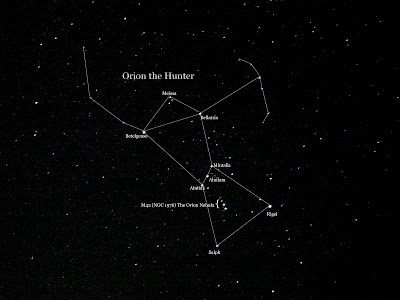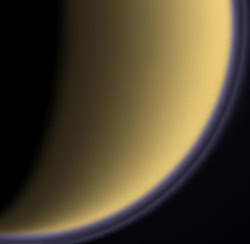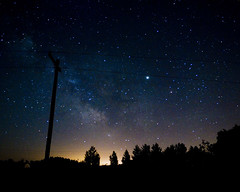December 31, 2007
Featured Flickr Photographer: OpoTerser
Great Job OpoTerser!
December 29, 2007
Mars Near To Earth

Orion, the Hunter


Constellation Name: Orion
Observed Date: 12/27/07, 8:14pm EST
December 23, 2007
Things to See in 2008
 Comets - There will be quite a few comets coming around in 2008. Four of these will likely be visible with binoculars. 8P/Tuttle will remain visible for awhile. For a complete list of comets, check resources at aerith.net and the Institute of Astronomy to see what we can look forward to in 2008.
Comets - There will be quite a few comets coming around in 2008. Four of these will likely be visible with binoculars. 8P/Tuttle will remain visible for awhile. For a complete list of comets, check resources at aerith.net and the Institute of Astronomy to see what we can look forward to in 2008. Planets & Moon - Look forward to many solar and lunar eclipses. Also check out the many planets coming into opposition (their closest approach to Earth) and conjunctions (in which planets appear very close to each other). A full list of expected phenomena can be found at Sea and Sky.
Planets & Moon - Look forward to many solar and lunar eclipses. Also check out the many planets coming into opposition (their closest approach to Earth) and conjunctions (in which planets appear very close to each other). A full list of expected phenomena can be found at Sea and Sky. Asteroid Events - Any dedicated asteroid hunters out there can check out Poyntsource for a complete list of all global asteroid events. This site even let's you import information into Google Earth.
Asteroid Events - Any dedicated asteroid hunters out there can check out Poyntsource for a complete list of all global asteroid events. This site even let's you import information into Google Earth. Meteor Showers - According to the International Meteor Organization, " The meteor year ahead starts well for the stronger showers, with moonless maxima for the Quadrantids, α-Centaurids, η-Aquarids and δ-Aquarids, but things go somewhat awry in August with the Perseids peaking near full Moon, while the Orionids in October, the Leonids in November and the Geminids in December are even worse-placed." Check out their 2008 calendar for a full listing of what to expect when meteor hunting in 2008.
Meteor Showers - According to the International Meteor Organization, " The meteor year ahead starts well for the stronger showers, with moonless maxima for the Quadrantids, α-Centaurids, η-Aquarids and δ-Aquarids, but things go somewhat awry in August with the Perseids peaking near full Moon, while the Orionids in October, the Leonids in November and the Geminids in December are even worse-placed." Check out their 2008 calendar for a full listing of what to expect when meteor hunting in 2008.The year 2008 will be a great year for observing, and remember, 2009 is the International Year of Astronomy.
December 22, 2007
Flickr Find: Jupiter & Computer Science Geek
Tunguska-sized Asteroid Misses Earth; Sets Sights on Mars

December 20, 2007
Peace on Earth
Check out the Earth and Weather Space to find out what he said!
Ursid Meteor Shower
 Very cool mission idea. Too bad that this meteor shower won't be easy to view from North America; seems interesting. Maybe we'll be lucky enough to catch a stray...
Very cool mission idea. Too bad that this meteor shower won't be easy to view from North America; seems interesting. Maybe we'll be lucky enough to catch a stray...I usually like to include an amateur photo of any meteor shower I've found, but I've yet to actually find any amateur astrophotography regarding the Ursids (other than the host comet 8/P Tuttle). Seems this is a difficult one to image; let me know if anyone is able to.
Happy meteor hunting!
Sorry for Slow Postings
Thanks for your patience!
December 18, 2007
Mars At Its Closest Photograph
 This is a photo by Alan Dyer of what Mars looks like from Earth in an overexposed photograph. Check out how much brighter it is than Orion!
This is a photo by Alan Dyer of what Mars looks like from Earth in an overexposed photograph. Check out how much brighter it is than Orion!
 Hubble released this image yesterday of Mars at its closest point to Earth. Great time for Mars astrophotography!
Hubble released this image yesterday of Mars at its closest point to Earth. Great time for Mars astrophotography!
December 17, 2007
Comet Visible with Binoculars

 I found a new (to me) astronomy/astrophotography blog called Flintstone Stargazing, and its really cool. Check it out; this guy even has some new pics of Comet 8P/Tuttle from this year like the one to the right!
I found a new (to me) astronomy/astrophotography blog called Flintstone Stargazing, and its really cool. Check it out; this guy even has some new pics of Comet 8P/Tuttle from this year like the one to the right!Mars Comes Closest to Earth Tomorrow

 Courtesy of Sky & Telescope Observing Blog, we have this handy chart to help us plot Mars' position in the sky, though it's really a formality at this point since it is so easily visible. Look to the constellation Gemini, and it should be easily visible as it is by far the brightest object in that section of the sky.
Courtesy of Sky & Telescope Observing Blog, we have this handy chart to help us plot Mars' position in the sky, though it's really a formality at this point since it is so easily visible. Look to the constellation Gemini, and it should be easily visible as it is by far the brightest object in that section of the sky.December 14, 2007
Mars Exploration: A Timeline
Check it out here!
December 13, 2007
Hotspots on Enceladus

December 7, 2007
Odyssey Moon Enters Google X Prize

Odyssey Moon, a British-based private spaceflight company, is seeking Google's $30 million X-Prize for successfully landing a rover on the Moon.
Headquartered on the tax lenient Isle of Man in the Irish Sea, the company, brainchild of CEO Robert Richards (founder of International Space University), is fixed to win this new age space race.
The company consists of many experienced space engineers, and is potentially one of the strongest competitors at this point.
The Google X-Prize requires a team to land a rover capable of moving 500 meters and transmitting back video, data, and images to qualify for the entire prize by December 31st, 2012.
Richards, confident of his company's ability, has been quoted as saying, "We believe the Google Lunar X Prize goals are achievable. And we do intend to win."
They intend to reduce the cost of moon travel "by an order of magnitude."
He describes the moon as "an eighth continent rich in energy and resources floating just offshore." Very accurate considering the Helium-3 isotope, an extremely efficient, potent, and clean fuel that could power the Earth, in its entirety, for many centuries.
Along with Carnegie Mellon and a slew of other potential teams, its great to see the competition heating up. The moon is the "gateway" to the private sector of solar system exploration.
Look out moon. We're coming back, and this time it's for good!
December 6, 2007
Voyager 2 Approaches Termination Shock

 Since the heliosphere moves back and forth, it is estimated that Voyager 2 will cross the termination shock twice: once in the next month or two and again in the middle of 2008. The spacecraft is now in the outer heliosphere, beyond which lies galactic space.
Since the heliosphere moves back and forth, it is estimated that Voyager 2 will cross the termination shock twice: once in the next month or two and again in the middle of 2008. The spacecraft is now in the outer heliosphere, beyond which lies galactic space.How to Get Your Wife Interested In Astronomy!
 Check out the full scoop on Daily Galaxy
Check out the full scoop on Daily GalaxyWell fear not, because there's one astronomical discovery she will be interested in. The star formerly known as BPM 37093, located in the constellation Centaurus, is actually a large, crystallized carbon mass nearly 2,500 miles in diameter. Don't let the big words fool you: this crystallized carbon is basically a gigantic diamond!
A diamond this large is literally 10 billion-trillion-trillion carats; the number is so incredibly huge it would be followed by 34 zeroes.
The carbon core of white dwarf stars often crystallize into diamonds. This is the largest diamond yet located in the galaxy.
That should get some wives interested...
Adapted from: Daily Galaxy
Geminid Meteor Shower

December 1, 2007
Life's Precursors Found in Titan's Atmosphere
 Despite not having nearly any oxygen at all, the atmosphere on Titan has something very interesting in it: negative ions.
Despite not having nearly any oxygen at all, the atmosphere on Titan has something very interesting in it: negative ions.These ions act as building blocks that more complex organic molecules form from. Carbon can form using these polycyclic aromatic hydrocarbons, PAHs, which have been mentioned in this blog before on the post Why I Think There's Life on Mars...
Check out even more details on the Astronomy Report blog which has an adapted version of the official release by University College London.
This makes one think... if Titan has the building blocks for life on it, could there be life on it? I know it rains methane on the moon and has lakes and oceans of methane and that its super-cold, however, what if water was as acidic and destructive to organisms living on Titan as liquid methane is to humans living on Earth? What if the temperature of Earth is as blazing hot to an organism on Titan as the surface of Venus is to us earthlings?
Just food for thought!
Enthusiasts: Vote Prospace!
 Presidential candidate Obama seeks to delay the already long-delayed Constellation space program. The space program
Presidential candidate Obama seeks to delay the already long-delayed Constellation space program. The space program
Chang'e 1 vs. Kaguya

Vs.
Kaguya

While Kaguya is undoubtedly prettier, both missions, hot-on-the heels of each other, are part of a plan laid out by The Planetary Society called the Lunar Decade. Each of these missions, and India's planned mission, Chandrayaan 1, play an integral part in the plan.
Exciting New Fusion Technology

- Travel to Titan would take 75-90 days.
- 24 hours to lunar orbit from low earth orbit.
- Travel to Mars would take 33-38 days.
Amazingly, these almost ridiculous travel times are accompanied by what the general public likes: an equally ridiculous low cost. Cost can be as low as these figures:
- $200 million of research, development, building, and testing.
- 2 8-gigawatt thermal fusion engines are nearly 100x less expensive than our best systems available today.
Check out a the Advanced Nanotechnology Blog for more in detail information. Definitely a must for any aspiring space junkie!
I was referred to this site by the always awesome Bad Astronomy Blog.


